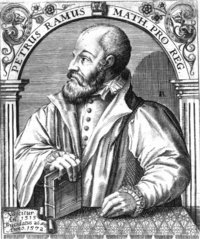Petrus Ramus
|
|
Petrus Ramus, or Pierre de la Ramée (1515 – August 24, 1572), French humanist, was born at the village of Cuth in Picardy, a member of a noble but impoverished family: his father was a charcoal-burner.
Having gained admission, in a menial capacity, to the college of Navarre, he worked with his hands by day and carried on his studies at night. The reaction against scholasticism was still in full tide; it was the transition time between the old and the new, when the eager and forward-looking spirits had first of all to do battle with scholastic Aristotelianism. Ramus outdid his predecessors in the impetuosity of his revolt. On the occasion of taking his degree (1536) he actually took as his thesis "Everything that Aristotle taught is false." This tour de force was followed up by the publication in 1543 of Aristotelicae Animadversiones and Dialecticae Partitiones, the former a criticism on the old logic and the latter a new textbook of the science. What are substantially fresh editions of the Partitiones appeared in 1547 as Institutiones Dialecticae, and in 1548 as Scholae Dialecticae; his Dialectique (1555) a French version of his system, is the earliest work on the subject in the French language.
Meanwhile Ramus, as graduate of the university, had opened courses of lectures; but his audacities drew upon him the hostility of the conservative party in philosophy and theology. He was accused of undermining the foundations of philosophy and religion, and the matter was brought before the parlement of Paris, and finally before Francis I. By him it was referred to a commission of five, who found Ramus guilty of having "acted rashly, arrogantly and impudently," and interdicted his lectures (1544). He withdrew from Paris, but soon afterwards returned, the decree against him being cancelled through the influence of the cardinal of Lorraine.
In 1551 Henry II appointed him professor of philosophy and eloquence at the Collège de France, where for a considerable time he lectured before audiences numbering as many as 2000. He published fifty works in his lifetime and nine appeared after his death. In 1561, however, the enmity against him was fanned into flame by his adoption of Protestantism. He had to flee from Paris; and, though he found an asylum in the palace of Fontainebleau, his house was pillaged and his library burned in his absence. He resumed his chair after this for a time, but in 1568 the position of affairs was again so threatening that he found it advisable to ask permission to travel. Returning to France he fell a victim to his opponents in the massacre of St Bartholomew (1572).
The logic of Ramus enjoyed a great celebrity for a time, and there existed a school of Ramists boasting numerous adherents in France, Germany and the Netherlands. As late as 1626 Francis Burgersdyk divides the logicians of his day into the Aristotelians, the Ramists and the Semi-Ramists, who endeavoured, like Goclenius of Marburg, to mediate between the contending parties. Ramus's works appear among the logical textbooks of the Scottish universities, and he was not without his followers in England in the 17th century. There is even a little treatise from the hand of Milton, published two years before his death, called Artis Logicae Plenior Institutio ad Petri Kami Methodum concinnata.
It cannot be said, however, that Ramus's innovations mark any epoch in the history of logic. His rhetorical leaning is seen in the definition of logic as the "ars disserendi"; he maintains that the rules of logic may be better learned from observation of the way in which Cicero persuaded his hearers than from a study of the Organon. The distinction between natural and artificial logic, i.e. between the implicit logic of daily speech and the same logic made explicit in a system, passed over into the logical handbooks. Logic falls, according to Ramus, into two parts--invention (treating of the notion and definition) and judgment (comprising the judgment proper, syllogism and method). This division gave rise to the jocular designation of judgment or mother-wit as the "secunda Petri." He is, perhaps, most suggestive in his emendations of the syllogism. He admits only the first three figures, as in the original Aristotelian scheme, and in his later works he also attacks the validity of the third figure, following in this the precedent of Laurentius Valla. Ramus also set the modern fashion of deducing the figures from the position of the middle term in the premises, instead of basing them, as Aristotle does, upon the different relation of the middle to the so-called major and minor term. On the whole, however, though Ramus may be allowed to have advanced logical study by the wholesome fermentation of thought which he caused, there is little ground for his pretentious claim to supersede Aristotle by a new and independent system.
See Waddington-Kastus, De Petri Kami vita, scriptis, philosophia (Paris, 1848); Charles Desmaze, Petrus Ramus, professeur au Collège de France, sa vie, ses ecrits, sa mort (Paris, 1864); P Lobstein, P. Ramus als Theolog (Strassburg, 1878); Émile Saisset, Les précurseurs de Descartes (Paris, 1862); J Owen, French Skeptics of the Renaissance (London, 1893); K Pranti, "Uber P. Ramus" in Munchener Sitzungs berichte (1878); Harald Høffding, Hist. of Mod. Phil. (Eng. trans., 1900), vol. i. 185; Voigt, Uber den Ramismus der Universität Leipzig (Leipzig, 1888).

